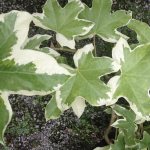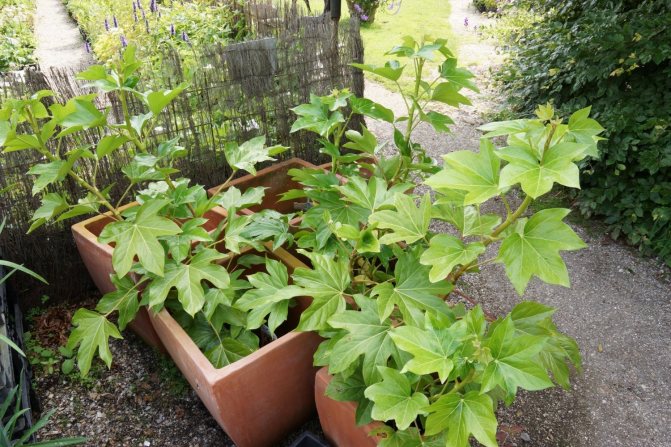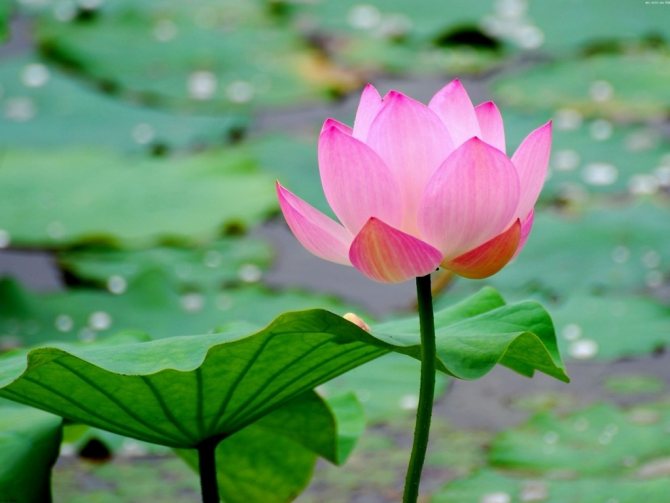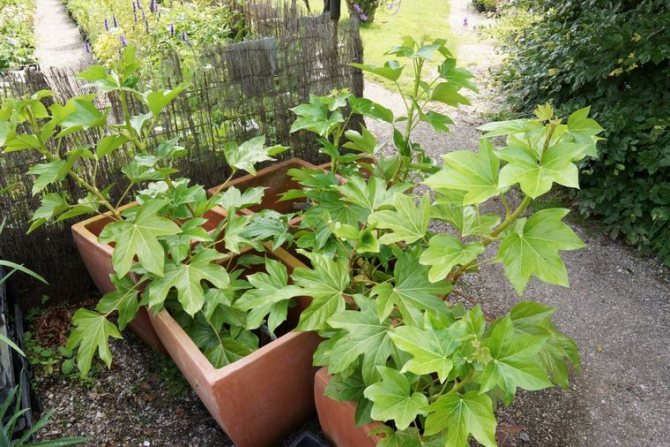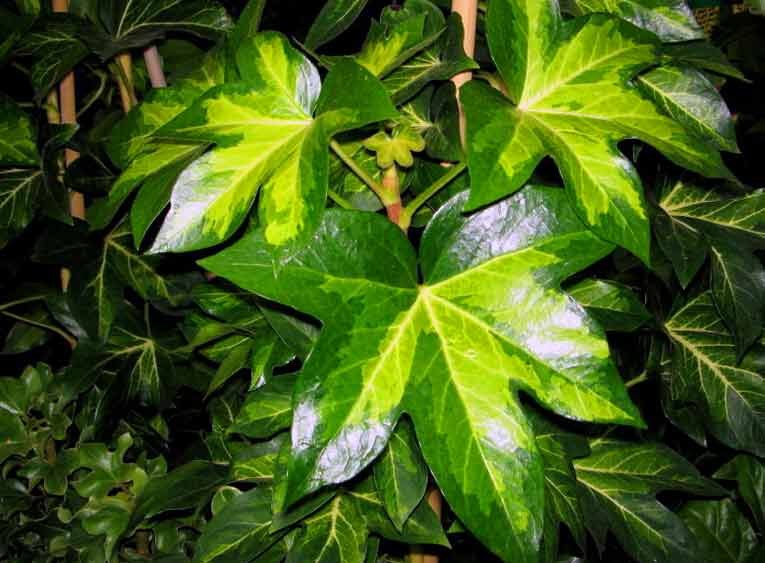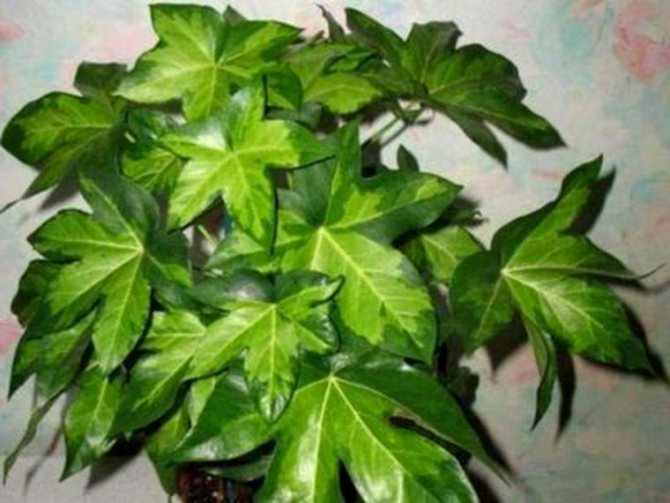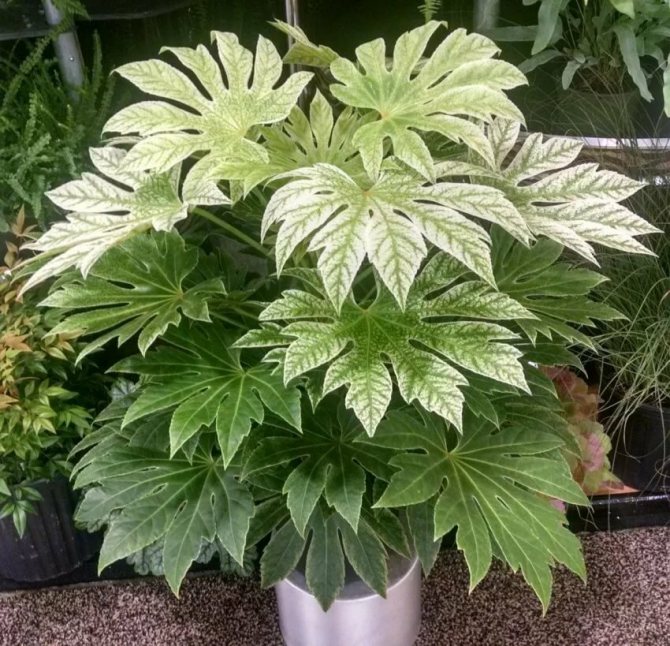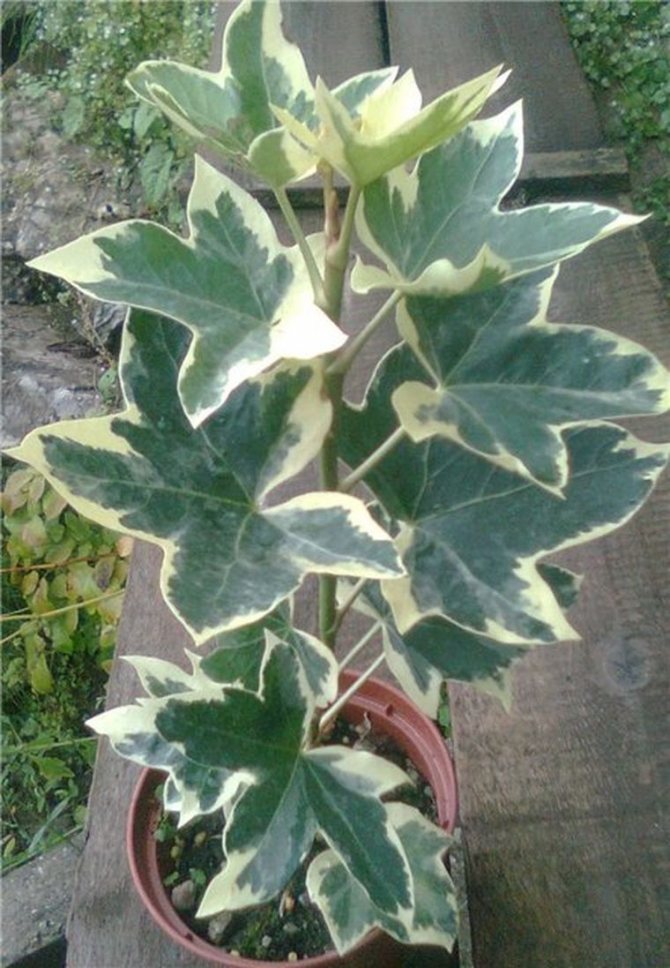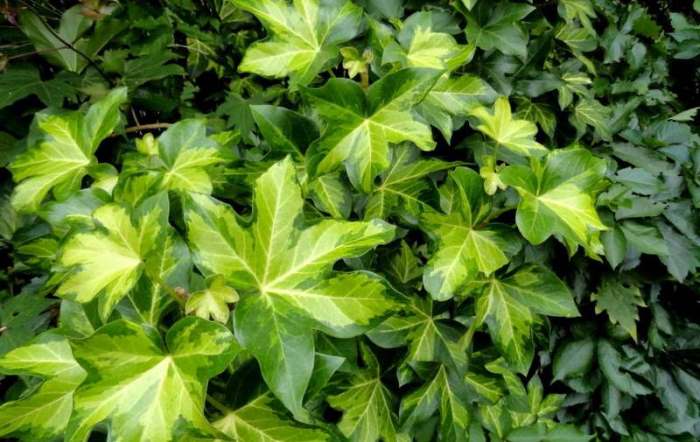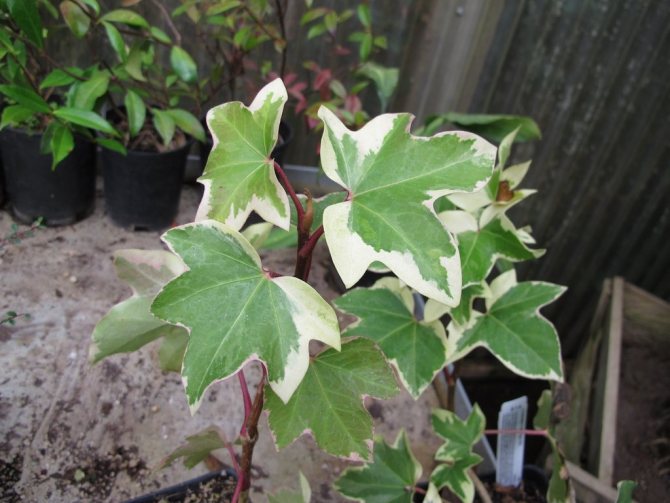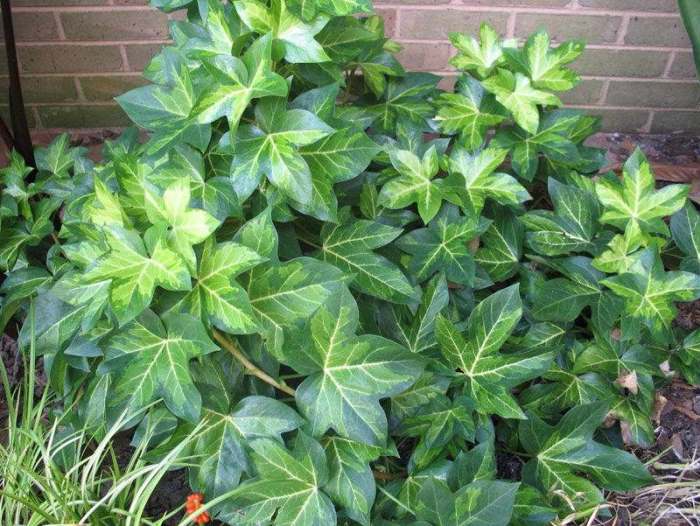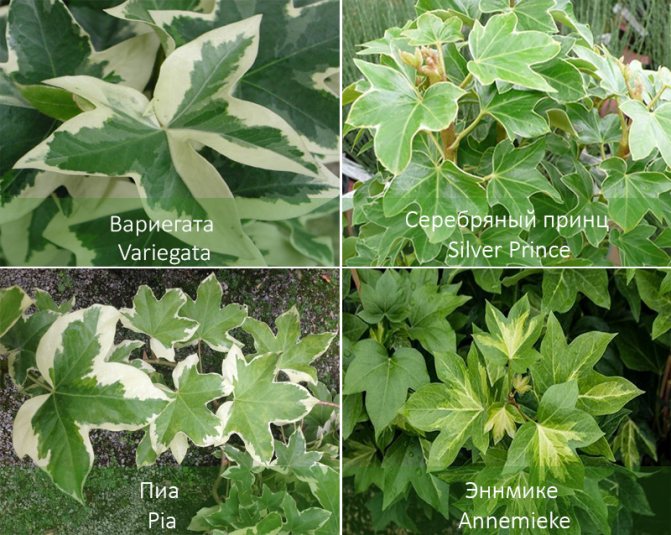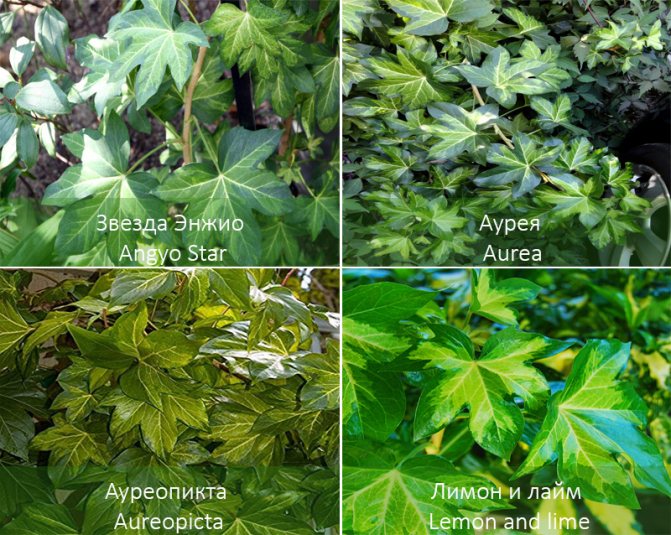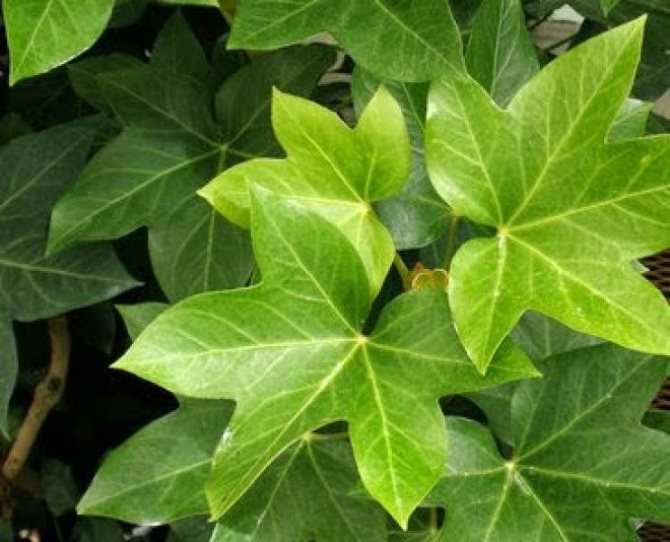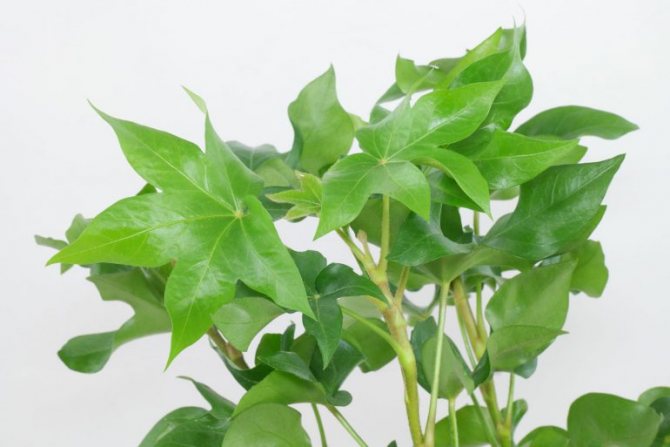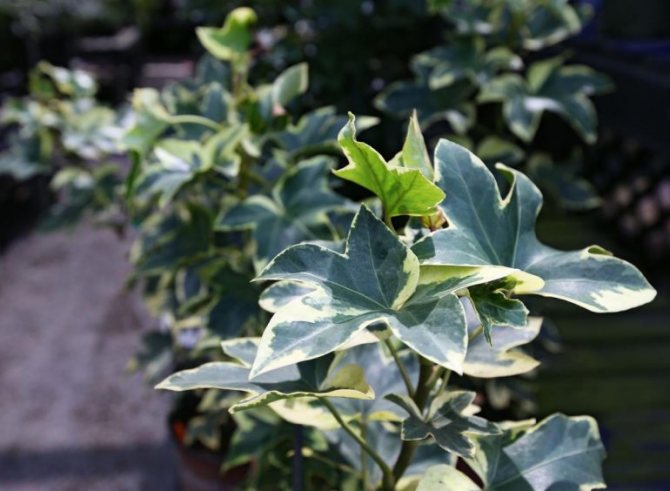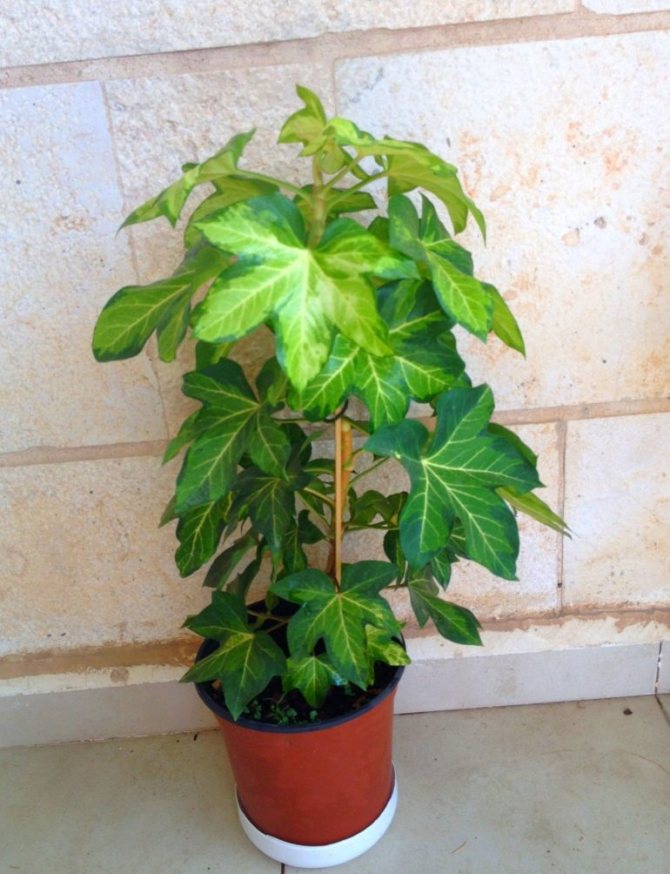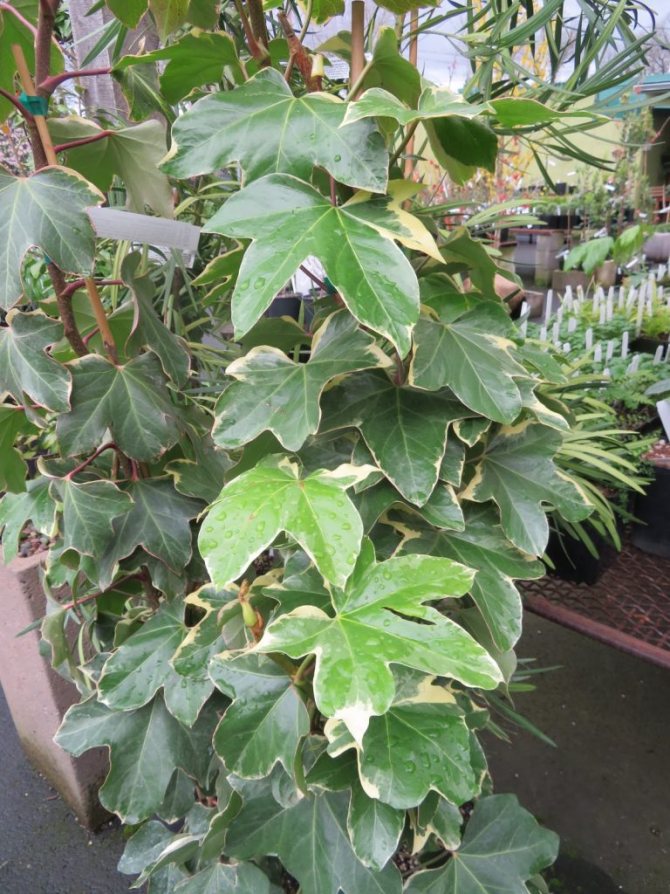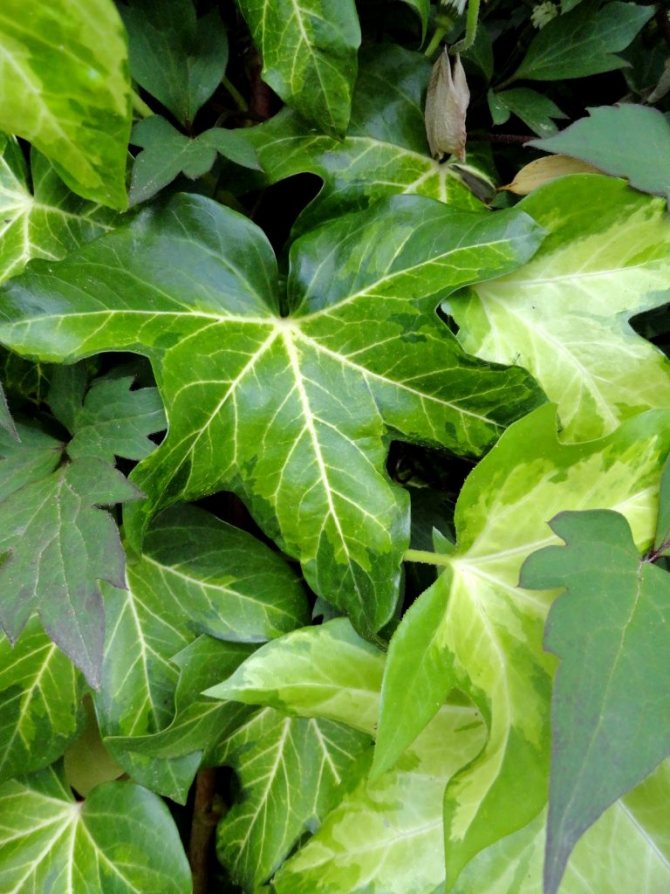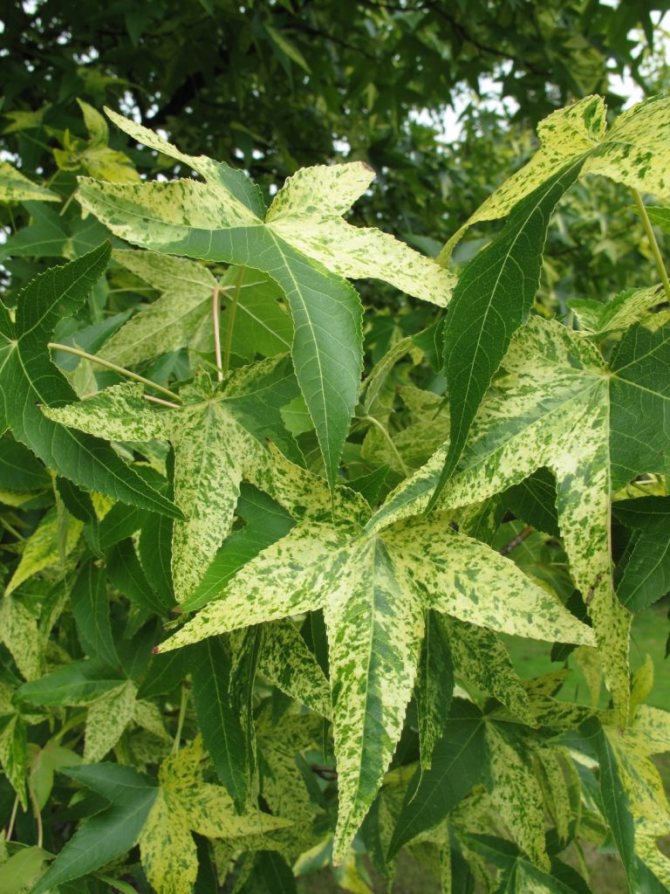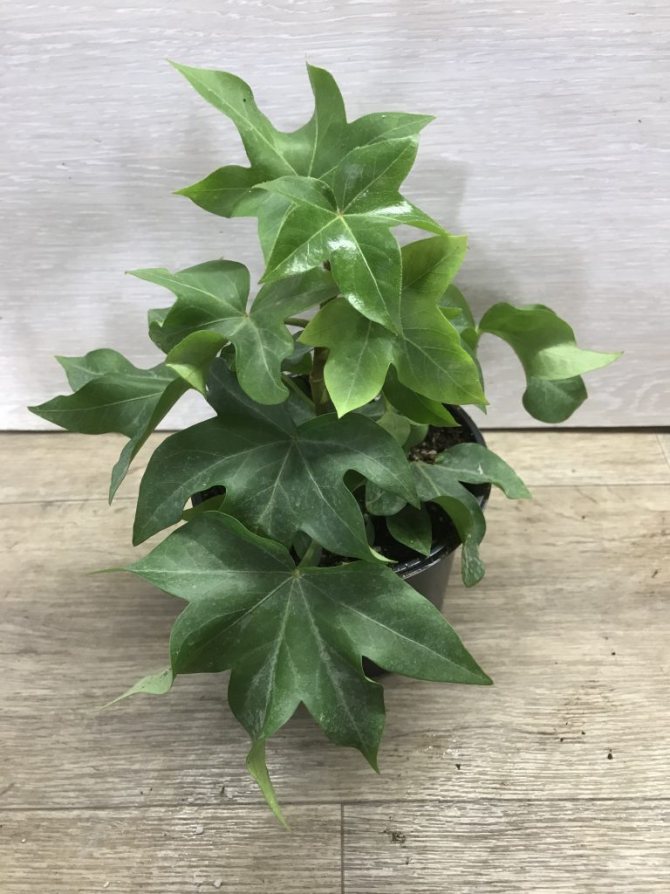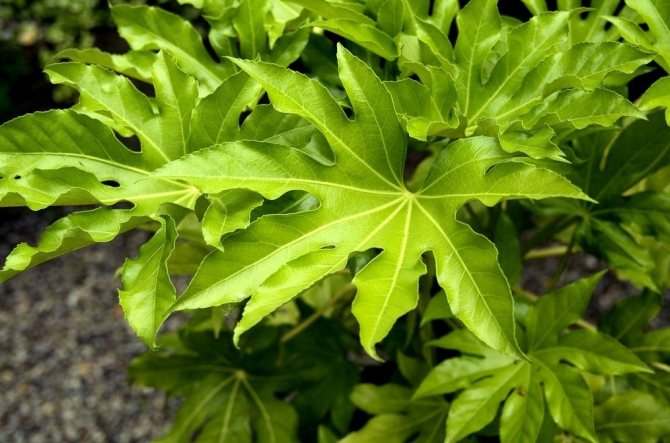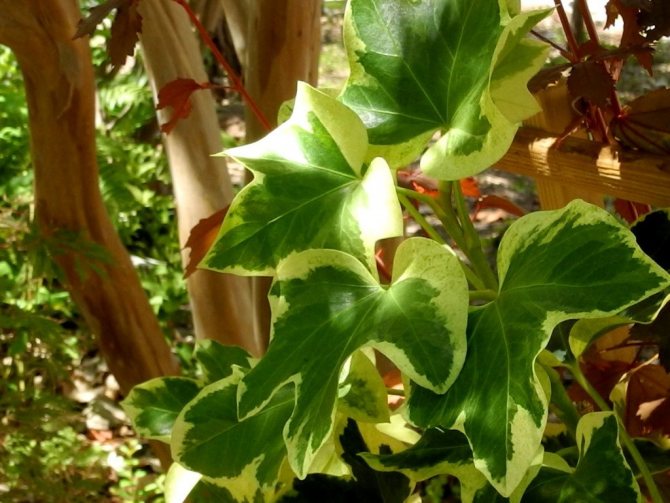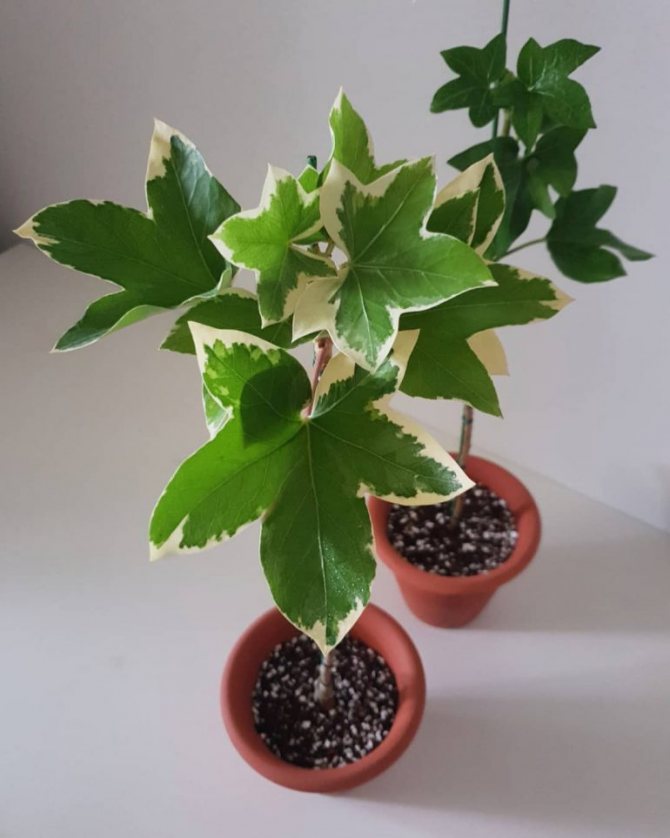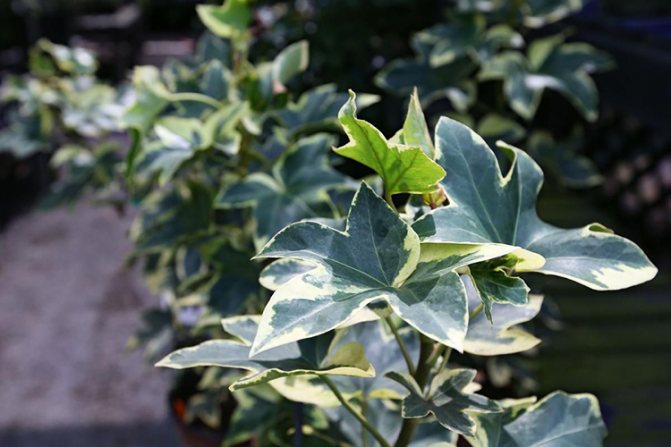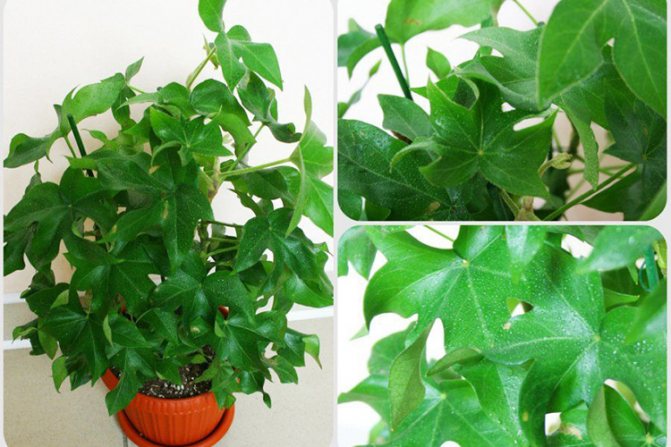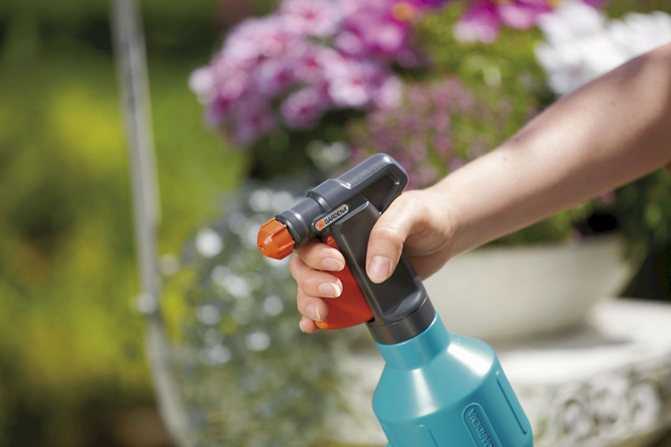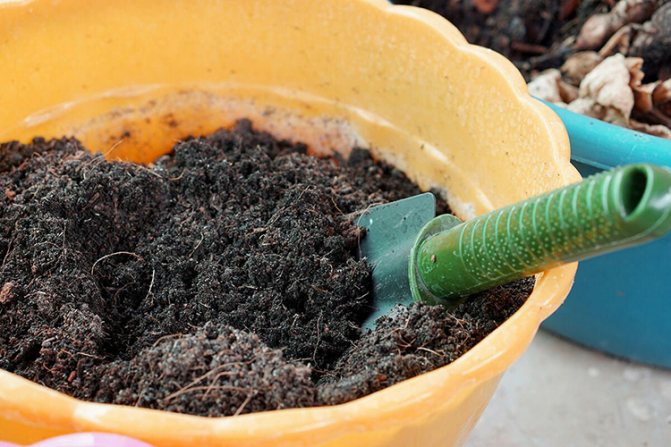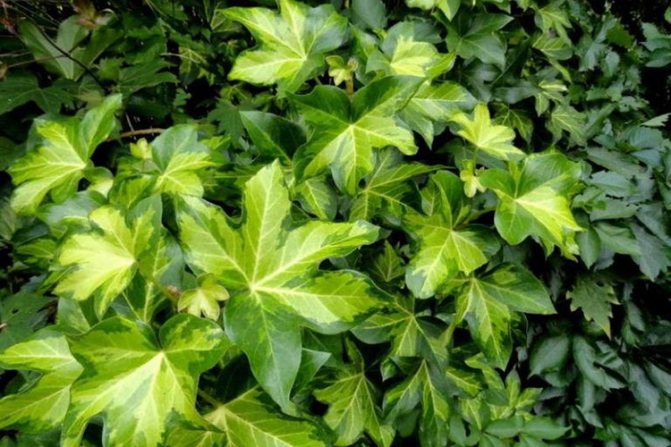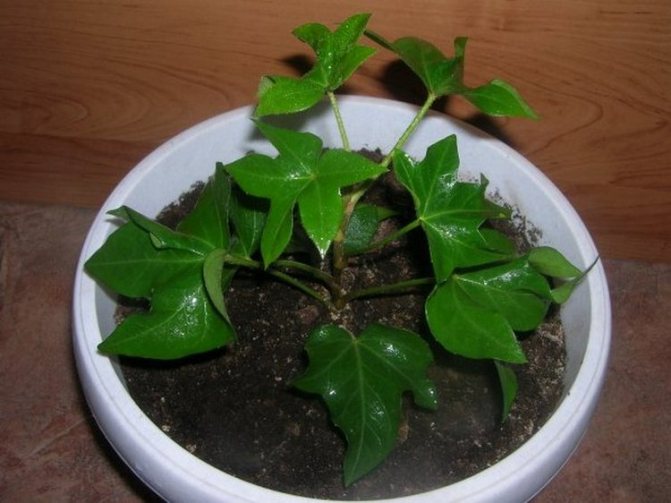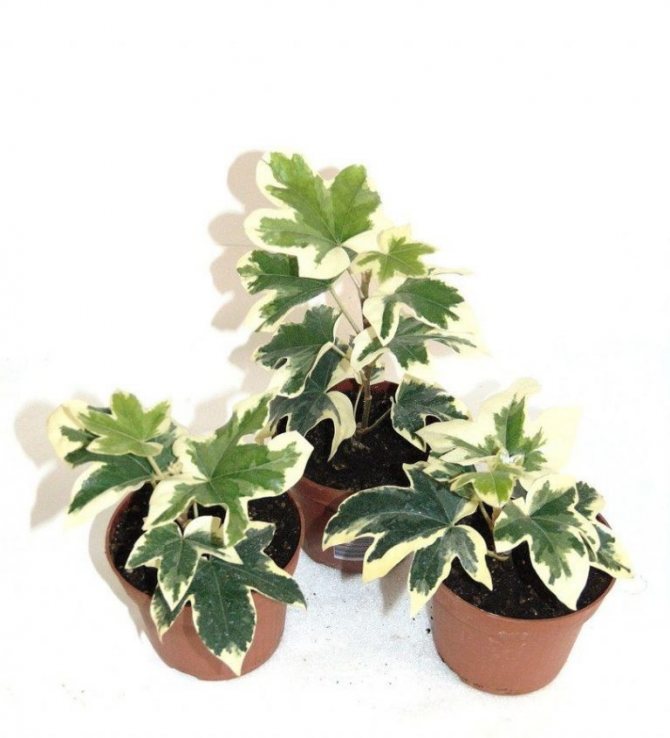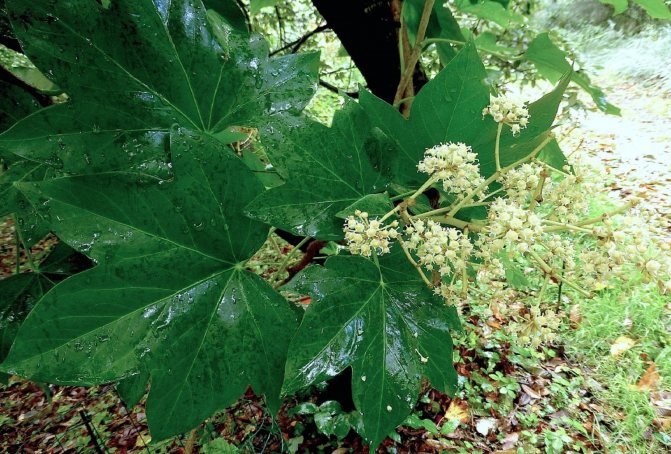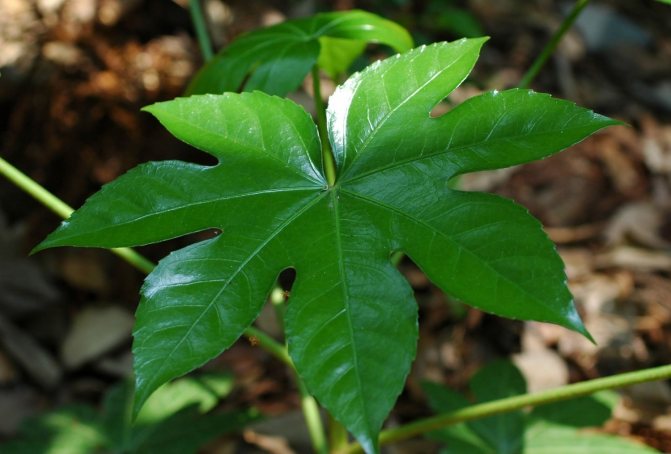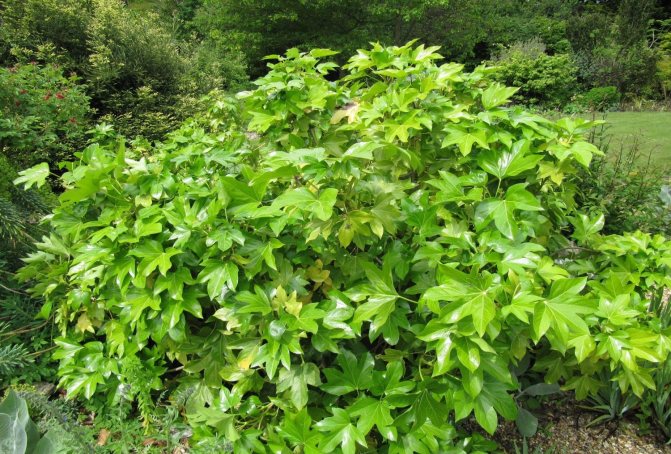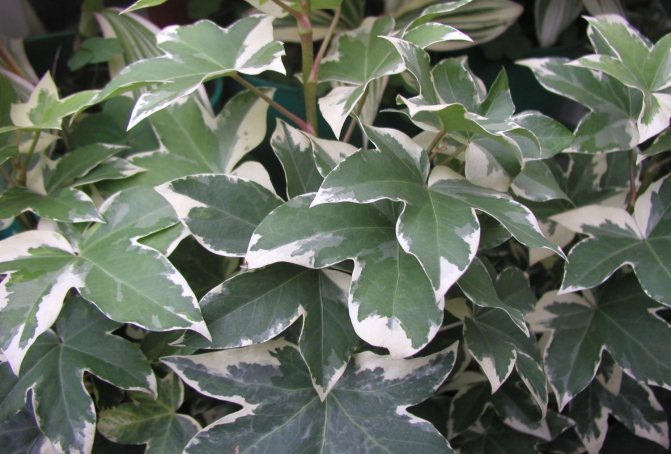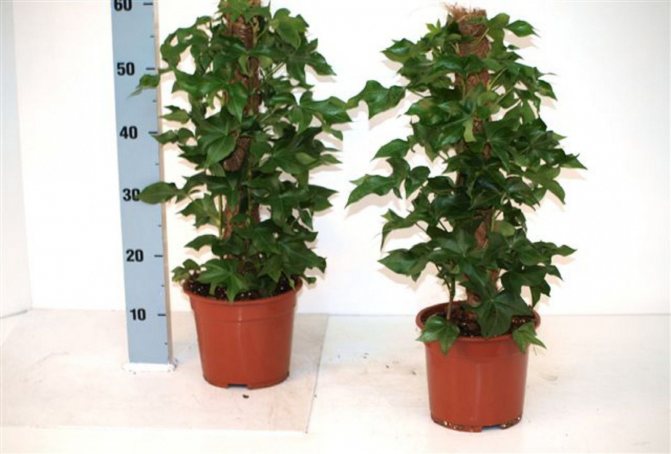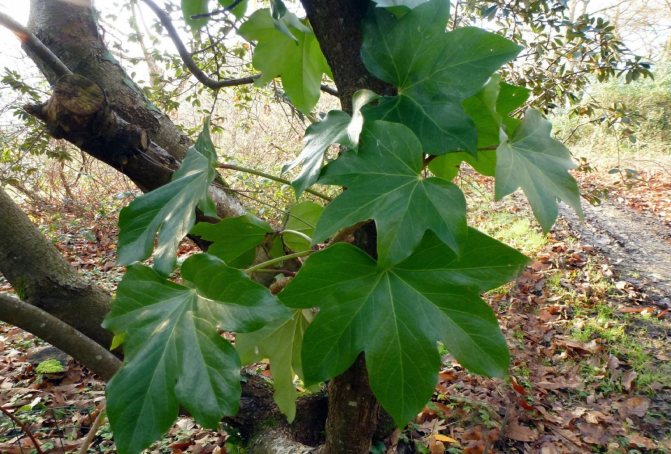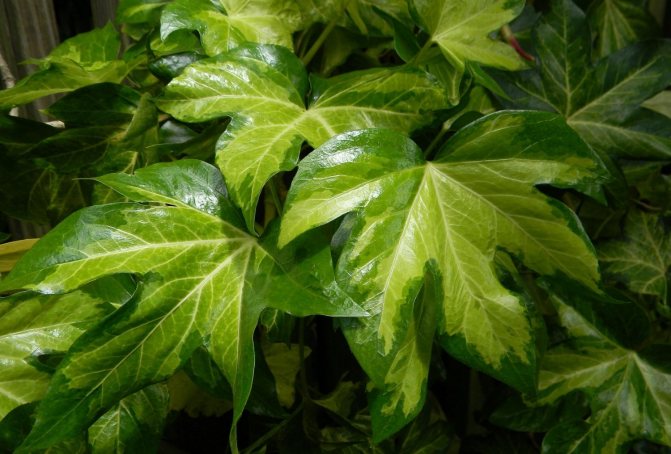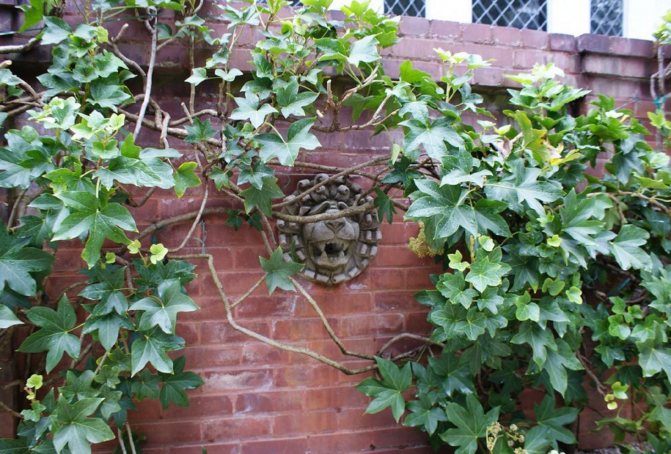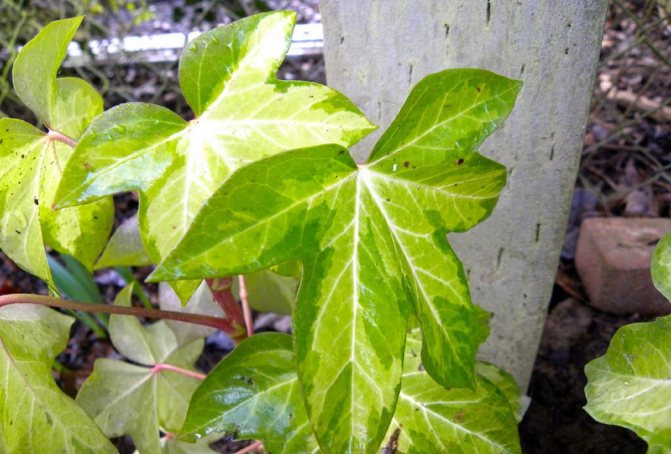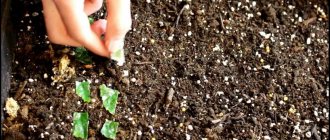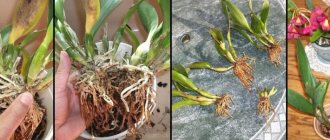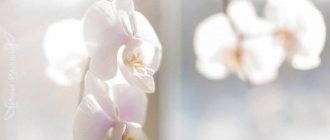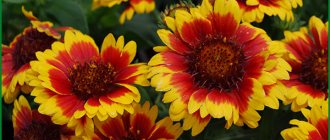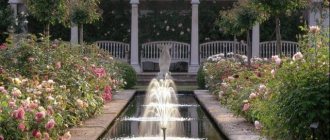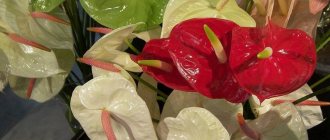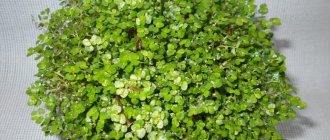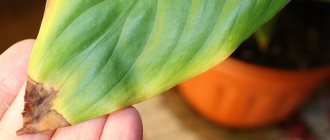Fatshedera is a spectacular artificially bred plant that has become very popular in a short time. Bred in 1912, it is a hybrid of Japanese Fatsia and Hedera. Botanists attributed it to the Araliev family. There is only one single species - Fatskhedera Lisi. It received its name in honor of the creators of this hybrid, the Lizzie brothers. Sometimes it is called "tree ivy", and this is no coincidence: at first, young shoots of the plant are green, and after a few years they begin to woody. It is noteworthy that the liana-like fatskhedera becomes only after it has already grown more than 1 m, and at first it looks like a bush, but it cannot cling to the supports on its own. The varieties differ mainly in the number and location of light cream spots or the presence / absence of a border on the leaves, which can reach 20 cm in Fatshedera. The flowers are whitish, small and indistinct. Fruits are round, dark blue-purple in color. Since the plant is distinguished by enviable plasticity, the Fatshedera is grown both as an ampelous plant, and as a bush, and as a tree. In regions where it is warm enough in winter, it is often used as a ground cover.
Botanical description
Fatskhedera is an exotic flower (rare, exotic), which soon after its appearance won the hearts of florists and florists. It is not only widely used in the design of flower arrangements, but also looks spectacular on balconies, terraces, conservatories, as well as in the foyer or large hall.
Fatshedera are recognized by large glossy dark green leaves, borrowed from fatsia and ivy - they never change their color. The dimensions of one leaf are impressive - 20 × 30 cm. The leaves are trifoliate or palmate-lobed.
Often, the edges of the leaves seem to be framed with a kind of cream or white irregular border, which gives the flower even more grace and beauty. This feature is characteristic of the subtypes of culture.
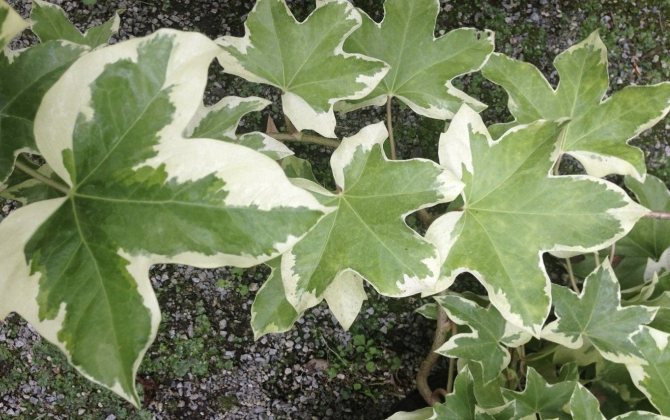
The liana itself can grow up to 5 m. At first, it has the shape of a tree with a weakly branched, semi-lignified, erect stem; if desired, this shape can be maintained constantly using a support (a stick made of wood or bamboo). Plucking the shoots will allow the tree to form an evergreen bush. In the absence of support, the stem of the flower begins to creep, and it gradually turns into a vine. Over time, the lignification of the stem begins and it becomes covered with a dark brown bark. The length of the fatshedera increases by 30–40 cm per year.
Did you know? Fatskhedera can often be found in large industrial enterprises, especially with work conditions harmful to humans, where it is used not only for decorative purposes, but also as a means of improving working conditions. Culture is capable of absorbing harmful substances, and its appearance has a calming and relaxing effect on workers.
In late summer - early autumn, spherical umbrellas-flowers of green-yellow or cream color appear on an adult liana. They are collected in paniculate inflorescences. The result of flowering is dark blue fruit-berries.
Liana is considered quite hardy and can grow even in open areas, but only in places where winters are mild.A flower grower should remember that this type of the Araliaceae family tends to have good lighting.
Description
Fatskhedera is grown as an evergreen type vine. It can reach about five meters in height. Its stem is weakly branched, not completely woody. Young plants will be thin and erect, begin to creep as they grow.
The leaves are large. They have three or five blades. The surface is glossy, the color is dark green. Sometimes there is a Fatskhedera with variegated leaves with a white border around the edge. Such variegated species have great decorative effect, however, they cannot please their owners with endurance.
Fatskhedera itself is quite strong and resistant to the manifestation of the external environment. Therefore, it can be grown in areas with mild winters. Variegated plant species love a lot of light, grow rather slowly, and are grown indoors.
Varieties
Decorative varieties of fatsheders include:
- Variegata, the main difference of which is the cream or yellow border, framing the dark green foliage. Variegata grows quite quickly, but at the same time it has weak immunity and often suffers from various diseases, is affected by pests.
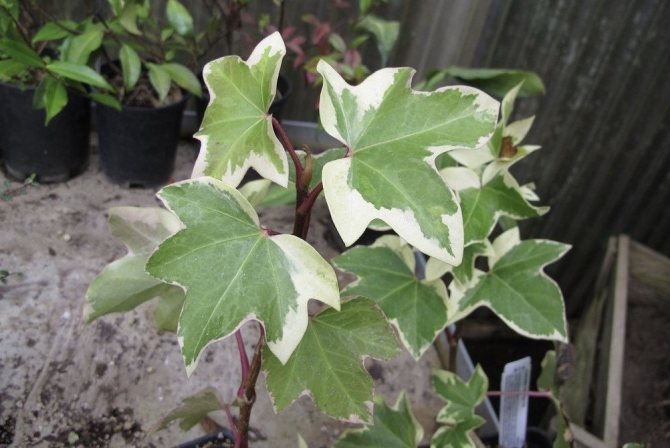

- Pia - the whole is covered with short leaves of a rich green color. They have motley-wavy edges, which are tightly adjacent to the stem.
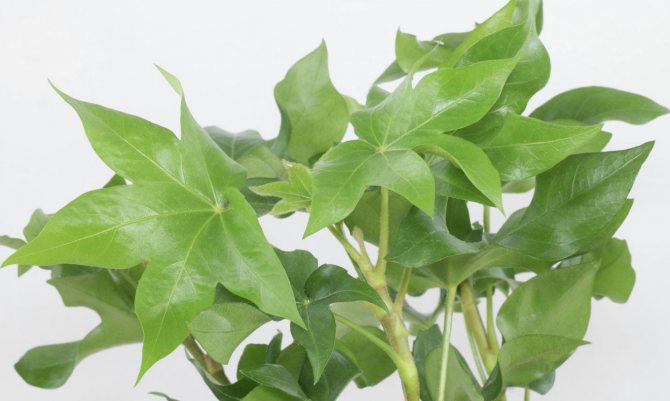

- The Silver Prince. The name itself speaks of the presence of silver - it is with a silver border that each leaf is framed.
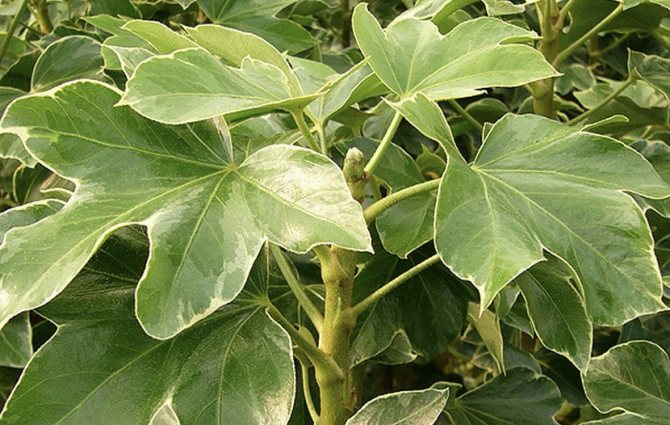

- Golden variety, a special feature of which is a spot of golden (yellow) hue in the center of each leaf.
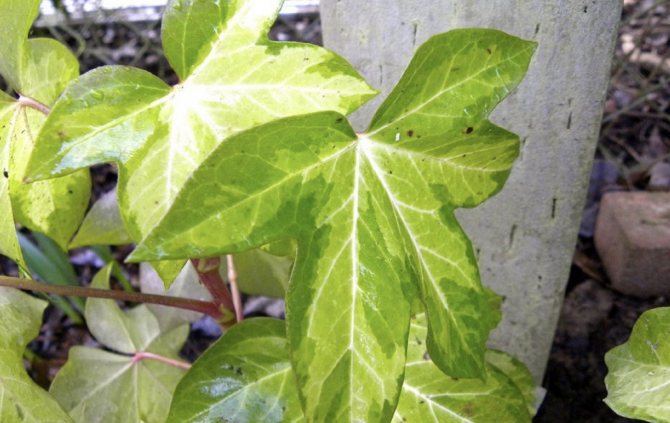

Types and varieties with photos
Lise (Fatshedera lizei) is the only species found in the Fatshedera genus. On its basis, a lot of varieties have been bred. The most popular are the following:
- Fatskhedera pia. Its dark green leaves with wavy edges are located on short petioles, tightly pressed against the vine.
- Fatskhedera variegat is distinguished by wide white stripes located along the edge of the leaf. The most whimsical variety, however, won the Royal Horticultural Society of England award for its spectacular appearance.
- Silver Prince - The special feature is a silver border on the edge of the leaf.
- Annmike is the most decorative variety. Its leaves are distinguished by a yellow-green center and an emerald hue around the edges.
- Fatskhedera lemon and lime: unusual color of the leaves - a combination of light and dark yellow-green hues.
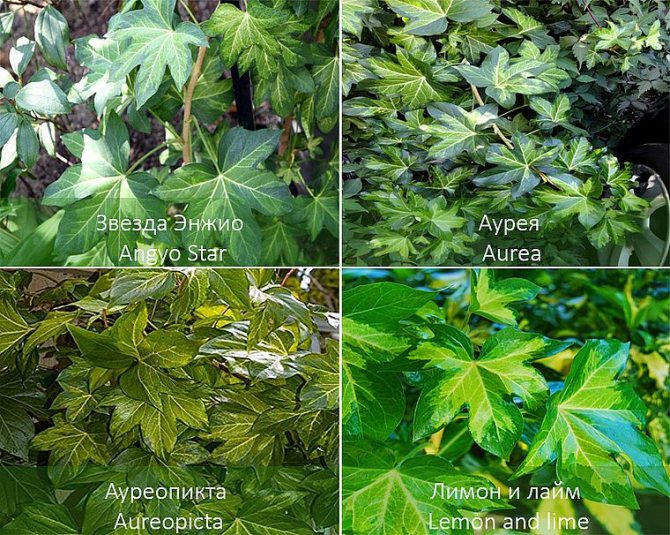

Fatshedera has established itself as an ornamental houseplant, however, it can grow outdoors, but only in regions with a warm climate.
What conditions need to be created at home
To successfully grow an evergreen liana in your own home, you need to provide it with the right place to live, that is, create the necessary conditions.
Seat selection
Fatshedera prefers good light, although it can grow in shaded conditions. The ideal level of light in the room is light partial shade. With the onset of warm seasons, the culture will feel better in the fresh air than in an apartment, for this purpose it is recommended to transplant it to the street. A shady patio is best.
Important! The main rule: the flower must be protected from direct sunlight.
—
the rays of the sun can cause burns to its foliage.
Temperature and humidity
Liana is resistant to high spring-summer-autumn temperatures, but when the temperature rises above + 25 ° C, it can become dull and lethargic. The optimal temperature regime in winter is + 10 ... + 15 ° С.
Air humidity should be moderately high. If the air temperature rises above + 18 ° C, it is advisable to spray the culture, organize a kind of shower.Such procedures are also useful for hygienic reasons, since they clean the foliage of the flower from dust and have a disinfecting effect. Moisturizing procedures should be carried out every 7 days. In addition, it is worth cleaning the leaves from dust with wet wipes once a week.
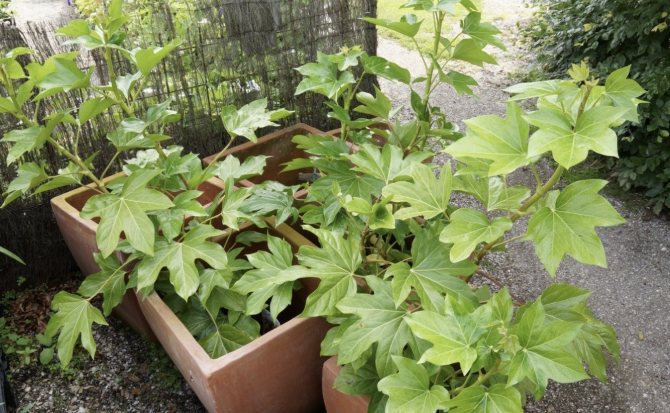

"Frenchwoman" should be protected from drafts and cold air currents.
Growing Fatsheders from Seeds
For a successful result, sowing is carried out in early spring or summer. On the surface of the calcined and moistened soil, the seeds are laid out at some distance from each other. After spraying the crops with a spray bottle again, they are covered with foil and placed in a well-lit place with a temperature of at least 25 ºС.
Regular moistening and aeration of crops will ensure rapid flower shoots. As soon as 2-3 leaves are finally formed, the sprouts are dived into separate containers.
How to care at home
Caring for a Fatskheder flower consists in organizing watering, feeding, pruning, transplanting. More details about each item.
Learn how to properly plant indoor flowers in a pot.
Watering
In warm and hot seasons (spring-autumn), the culture must be provided with frequent and abundant watering, but at the same time, the soil should not be overmoistened, as this can provoke root diseases of the plant. The liquid accumulated in the drip tray should be discarded. In winter, the number of waterings is reduced.
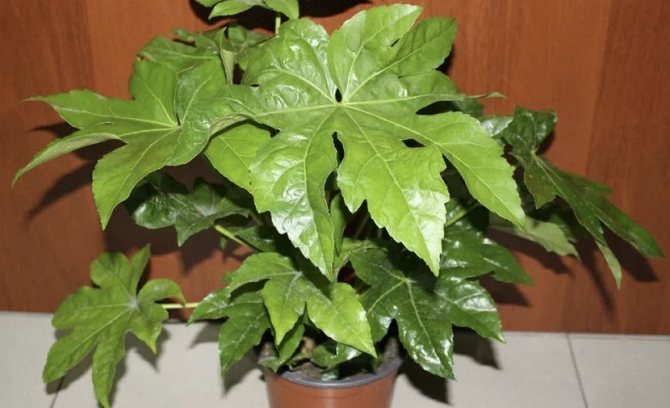

Approximate recommendations regarding the frequency of watering, depending on the air temperature:
- at a thermometer reading of + 24 ... + 26 ° C, the flower is watered every 2-3 days;
- at a temperature of + 20 ... + 24 ° C, the interval between waterings is 5-6 days;
- at a temperature of + 16 ... + 18 ° С watering should be done once a week and a half;
- at + 12 ... + 15 ° С one humidification per month is enough.
Observing these rules, it is worth making sure that the soil under the flower does not dry out completely. It should be loosened every 2-3 weeks.
Important! Fatskheder will report waterlogging with yellowed leaves, and a lack of moisture
—
a change in the shape of the crown and foliage falling down.
The best water for irrigation is rain or settled water, at room temperature. Irrigation type - drip irrigation, can be combined with spraying.
It is advisable to provide the flower root system with good drainage. So, the drained substrate should make up 30% of the total mass of the earth (the remaining 2/3 of the soil should be a sandy sod mixture with humus in proportions 1/2/1). It is best to use small particles of expanded clay or broken bricks as a drainage material.
Top dressing
During the time when the Fatshedera is growing most actively (early April - mid September), it needs to be supplied with high-quality and regular fertilizers. Top dressing should be of a complex, organic and mineral nature, they should be alternated. The frequency of dressing is 1 time per 10-14 days. With the onset of winter, fertilizing processes are stopped, since the fatshedera enters a state of rest.
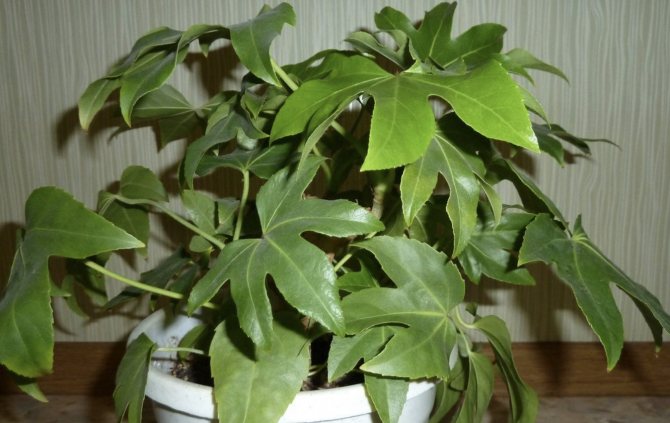

The necessary fertilizers can be purchased in specialized flower shops: you should ask for feeding for decorative leafy crops, for example, Vympel-2, Master Elite, Alliansed, Agricola, Bona Forte and others.
Pruning
Fatskhedera is a plant that is distinguished by its elasticity, flexibility and plasticity. Despite such data, without pruning, it can form one strong central shoot (stem), which negatively affects the development of lateral ones. This can lead to a diminution of decorative functions, that is, without trimming, its appearance will suffer. The fatskhedera is pruned after reaching a height of 30 cm to stimulate the branching process.
Important! Often, lateral shoots develop poorly even after pruning - they can dry out, and the bush, even with all the necessary care rules, will branch poorly, have a poor and depressed appearance.To grow a lush and bushy vine, plant 2-3 seedlings in one pot and prune each one in time.
Transfer
The French liana is recommended to be transplanted annually until the age of 5 years; after that, the plant should be transplanted every 2-3 years (while it is worth changing the top layer of the soil annually). But, if you want to become the owner of a lush and graceful fatshead, then do not be lazy and transplant it annually, regardless of age.
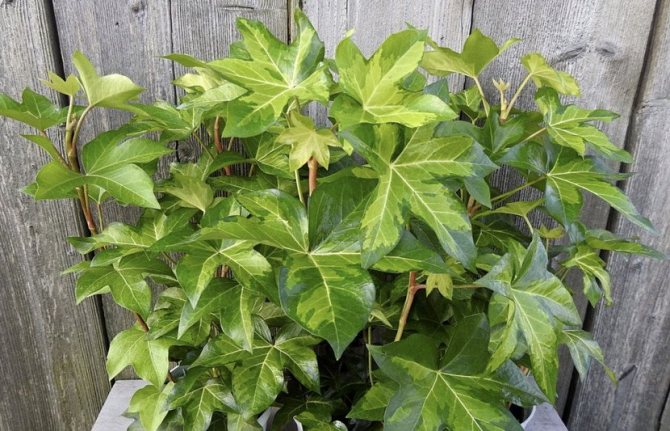

The container for planting should be deep and not wide, which will allow the bottom of the pot to drain well without compromising the growth of the root system. It is worth remembering to increase the size of the container for a flower. So, each next pot should be 2-3 cm in diameter larger than the previous one. The best time to transplant is early spring (around early April), before the growing season begins. The acidity of the soil should be low or neutral. Vine transplanting should be carried out by the transshipment method, that is, keeping the earthen lump.
This process should consist of the following steps:
- Preparing the pot and soil.
- Slight moistening of the soil under the plant for 2-3 days before the transfer process. This is necessary so that a clod of earth does not crumble.
- Removing fatsheders from the previous container, along with the ground. To safely remove the plant, place the pot on a flat, hard surface and tap the edges a little. You can also gently run a knife along the inner edges of the pot and separate the soil from the sides of the container. Then the vine is carefully pulled out. The pot can be turned to the side for safe removal.
- Examination of the roots in order to remove diseased or rotten ones. If, during the examination, diseased or damaged roots were found, then the root system is completely cleaned of the soil in which it grew, and the foci of diseases on the roots are removed. If none were found, it is only necessary to remove the top layer of the old soil, and also to clean the lump from the remnants of the previous drainage (the roots that have grown into the old drainage system must be removed).
- Placing the vine in a new container. The root system is transferred to a new pot, filling the free space between the clod of earth and the edges of the container with new substrate. It is worth remembering that the distance from the top of the pot to the topsoil should be 3 to 5 cm.
- Compliance with the peculiarities of watering. Considering the fact that the culture was moistened for 2-3 days before transplanting, it is not necessary to water it immediately after transplanting. The plant should be given some time (1-3 days) to dry the wounds formed on the roots during the transplant procedure.
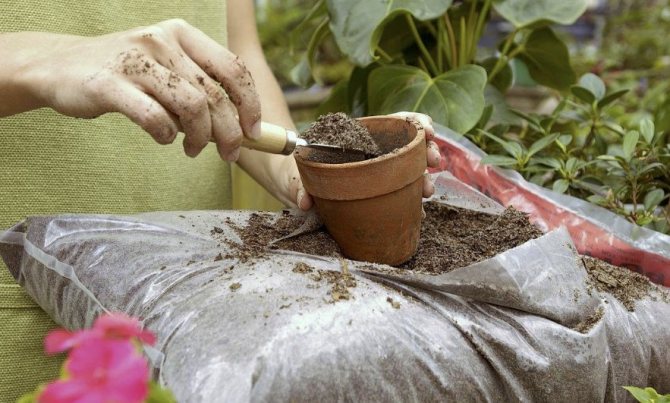

Fatskhedera is a variegated, evergreen liana, a favorite of flower growers.
Save the article for yourself or share it on your favorite social networks:


Fatskhedera is a variegated, evergreen liana, a favorite of flower growers.
The Fatskhedera plant is the result of crossing two other plants - ivy and Japanese fatsia. It was brought out in France and for good reason, because its feature is persistence, little need for daylight and evergreen. In addition, the plant grows rather quickly. This means it is well suited for decorating private houses and gardens. Frequent pruning of the plant will help resolve the issue with the direction of growth, but if you want it to grow and grow, it is enough to provide Fatsheder with a large flower pot and coolness.
General information about Fastheder Lisa
Fatshedera lizei is a variety that is more popular with gardeners and is easy to grow. This is a vine with climbing shoots, it is evergreen and needs support. Shoots lignify over time. One stem of a face can grow up to several meters in length! The leaves are also quite large - they can reach up to 25 cm in diameter and are finger-lobed. Depending on its species, the leaves can be dark green or creamy spots.The surface is leathery. This liana rarely blooms. Paniculate inflorescences are collected in small greenish-yellow flowers. There is another Fatshedera species, Variegata, but it is less popular simply because it is difficult to grow. Its leaves have white edges.
Caring for Fatskhedera at home
If you decide to start Fatskhedera at home, and not in the garden, there are some points to consider. This plant is very fond of a light or shaded place, but at the same time without sunlight. This does not mean that the sun can harm the vine. But even in the hottest hours it is better not to keep it under the sun. In winter, it is better to move it closer to the window and to natural light. If this is not done, young shoots will stretch and look not as good as we would like. The room with Fatskhedera must be ventilated.
And more about the coolness. Good lighting doesn't mean hot. The vine feels best at 15 degrees Celsius. When growing, stick to 10 to 20 degrees. This vine grows fastest in spring and summer, which means that it is most necessary to water it during this period. Feeding can be given once a week. Solutions and fertilizers for decorative leafy plants are suitable. If the plant is indoors, in the summer its fox needs to be sprayed, taken out into the air, while putting it in the shade. In winter it can be watered less often, especially if the temperature is low. Fertilizers do not need to be given in winter.
Flower transplant and reproduction
If you just bought this plant and need to transplant it into a permanent pot, you need to buy or mix it up. The ideal option is a mixture of peat, sand, humus, leaf and sod land. To prevent waterlogging of the earth, it is better to add pieces of birch coal and small expanded clay to it. If you want to transplant a plant whose roots have already filled the entire flowerpot, it is best to do this in the spring. To do this, you need to buy a larger pot and at the same time update the soil, prepare a new earthen mixture. If you have an adult plant, it is enough to replant it once every 3 years.
In order to reproduce Fatskheder Lisa will have to wait for spring. This can be done with air layers or cuttings. To do this, you need to place the cuttings in a wet mixture of sand and peat. Cover the cuttings with plastic wrap and place where it is warmer. The plant should take root without any problem. In order to propagate the plant with air layers, you need to make a shallow incision on one of the branches, cover it with moss and then with a film. Moss needs to be moistened periodically to keep it constantly moist. You can see through the transparent film whether the roots have appeared or not. When it becomes clear that the roots have developed well, it remains only to cut off the branch and plant it in the ground.
Diseases and other problems
- If your Fatscherer leaves the edges and tips of the leaves brittle, dry and brown or pale spots, this may mean hot air or insufficient watering. If it is impossible to lower the air temperature, increase the humidity in the room and water the plant.
- If you find brown spots and wrinkled leaves on a flower, it is possible that the air in the room is too dry or the plant has been standing in direct sunlight for a long time. It is enough to move the flower to the shade.
- If the variety of your Fatskhedera implies a certain color and the leaves for some reason are of the usual green color, it is quite possible that it lacks lighting. So, for example, variegated creepers are more fond of warmth and light.
- If the leaves of the plant have drooped and, in addition to this, a fluffy bloom has appeared, immediately rearrange it to a drier and warmer place. Reduce watering.Do not forget to remove the damaged leaves, it is enough to observe the temperature about 15 degrees. To speed up the treatment, it is necessary to spray the flower with a fungicide and loosen the topsoil.
Finally
It is believed that the energy of Fatskhedera helps to cleanse the biofield of housing and is suitable for those who have a tense emotional situation at home. Not so much aggression, but pessimism, burdened and gloomy thoughts. It will contribute to the calmness and confidence of a person in business qualities. It will also help protect against chronic diseases and cleanse the air well. Especially suitable for those born under the signs of Libra and Virgo.
Fasthedera is such a wonderful plant that is suitable both for an apartment and a balcony, as well as for a winter garden or outdoor cultivation in the garden in the summer. Therefore, I hope that it will become more and more popular with flower growers.
If you have your own ideas, notes and tips for growing this cute creeper both at home and in the garden - share your experience and photos in the comments, they will definitely come in handy for our readers.
Comments, answers to questions
- Natalya Thank you for the information, and indeed, a very nice plant. I got interested.
Reply
- natasha How to distinguish fatshedera from Japanese fatsia?
Reply
- Tatyana My fatskhedera for some reason does not grow so bushy and colorful as in the photo, what am I doing wrong?
Reply
- Yana Will you share a process from fastheder lise?
Reply
How to propagate
"Frenchwoman" propagates by cuttings, the seed method, and also by air layers.
Cuttings
It is carried out in a warm season, best of all late spring - early summer. To do this, cut off the apical shoots 15 cm long, place them in a container with a substrate made of turf, humus and sand (2/1/1), and create greenhouse conditions, that is, cover with a film. With the appearance of buds on the handle, the film can be removed.
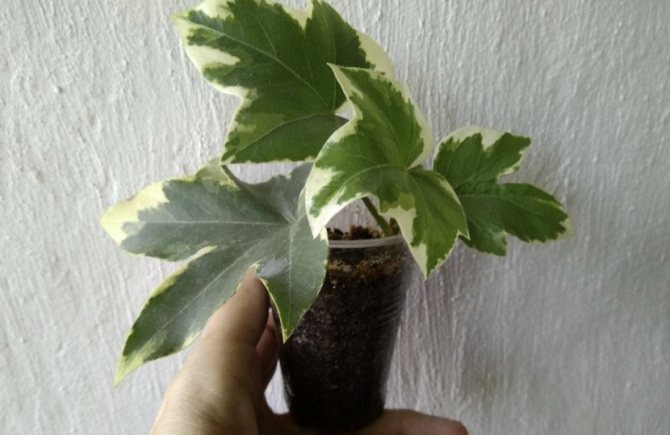

Air layering
The simplest and most popular method of culture propagation. This procedure begins in early April. The leafless stem of one of the shoots is slightly incised, wet sphagnum is applied to the incision site and all this is wrapped with a film. Provided that the moss is always moist, after 2 months, new roots will appear on the cut off site of the stem. Then the part of the stem covered with roots is cut out and placed in a previously prepared pot with a substrate.
In order for a new plant to take root well, the soil under it must be regularly moistened. It is also worth taking care of high air humidity: cover the young plant with a film or even a glass jar (for 7 days), which also contributes to its rapid rooting.
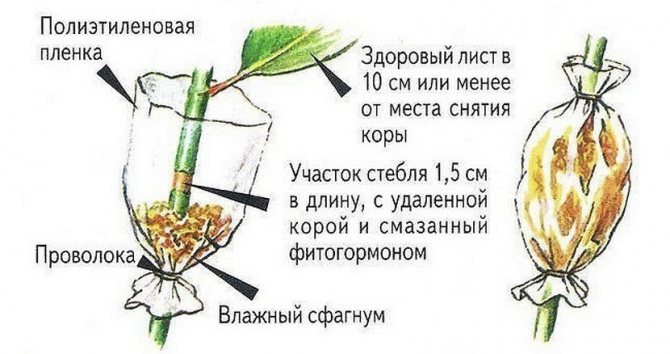

Seeds
This method is carried out using exclusively freshly harvested seed material (seeds ripen on an adult plant and they can be harvested independently at home). Fresh fruits are placed in the substrate without deepening, sprinkled with soil a little and greenhouse conditions are created using film, glass or a bag. Then the container is placed in a warm (+ 27 ° C) and dark room and wait for shoots that will appear a month later.
Reproduction
There are two main ways of breeding fatsheders:
- seed method;
- grafting.
It is very problematic to grow a flower from seeds, therefore, apical shoots are most often used to obtain a new plant. 2-3 nodes must be saved on them. It is recommended to plant several cuttings at once to give bulk to the future bush. The cut shoots are planted in moist soil, after which you need to create greenhouse conditions for them, covered with a film or a transparent container. It is best to do this process in the spring, however, at any other time of the year, the result will be no less effective.
Some professional growers propagate fatshedera with air layers. This is not easy.In order for aerial roots to appear on the shoot, you need:
- make cuts on a young shoot;
- apply foam rubber or cotton wool soaked in sweet water to them;
- wrap with polyethylene;
- after the appearance of the roots, you can cut off the shoot and plant it in a nutritious soil.
Growing difficulties
A flower grower who grows a fatshedera may face the following problems:
- Yellowing of the tips of the leaves, their fragility, spotting, dryness. This phenomenon is provoked by insufficient watering of the crop, or it grows in too hot conditions (the air temperature exceeds + 25 ° C). Solution to the problem: increasing watering and humidifying the air.
- If the leaves of the flower begin to wrinkle and become covered with large spots of brown color, the plant has received a sunburn. Do not forget to hide it from direct sunlight.
- The pallor of the leaves and the loss of their glossy gloss indicates a lack of light. Liana should be moved to a more illuminated place.
- The culture withers before our eyes, becomes dull, becomes covered with a downy coating of gray - it means that it is cold and the air is too humid. Solution to the problem: move the flowerpot to a room with the appropriate temperature and humidity. After relocation, remove the drooping leaves, loosen the soil under the vine and spray it with a fungicide.
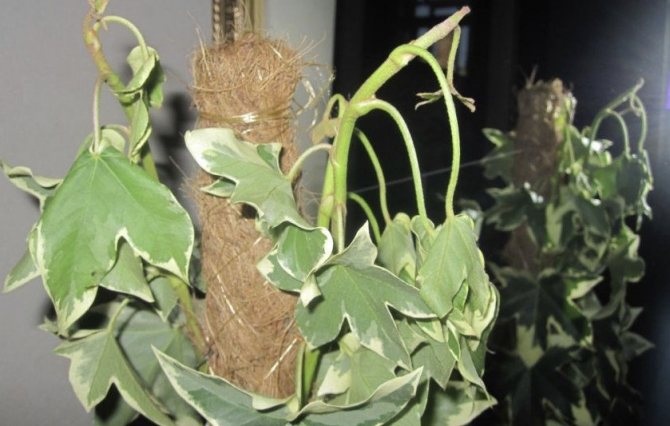

Important! Slight loss of leaves in an adult Fatshedera
—
it is not a growing problem, but a natural process.
Diseases and pests
As a rule, diseases appear in case of violation of the rules for caring for a fatshedera at home:
- With hypothermia, gray rot appears in the form of a fluffy bloom on the stems and leaves. It is urgent to remove damaged shoots and provide the bush with the correct temperature regime. In case of serious damage, the vine must be treated with fungicides.
- Excessive watering leads to powdery mildew or root decay. Transplanting from infected soil and cutting off damaged parts of a bush or horses will help to save the flower.
- Incorrect light conditions contribute to the loss of decorativeness and color or thermal damage to the leaves.
Fatskhedera pests are often affected. The greatest harm is caused by the Putin tick, scale insect, whitefly, mealybug. It is recommended to start the fight against them with the use of folk methods. Wiping the leaves with soapy water or alcohol has a good effect. Sometimes a simple sprinkling of the bush with warm water helps. Tobacco dust is also effective against insects.
If the vine is severely damaged, then it will not be possible to do without the use of insecticides. In specialized stores, there is a huge selection of drugs that will help save the vine.
Home value
Together with genetic characteristics, Fatskhedera took over from ivy and some omens and superstitions. So, it is believed that the flower has a bad effect on men, producing negative energy and aggression. The most superstitious say that the vine is even able to keep a man out of the house: at best, he will simply leave, at worst, he will die. In the house where the Fatskhedera grows, the representatives of the stronger sex will always try to leave the room with the flower, or even not enter it.
In addition, fatskhedera, like ivy, is classified as a plant - energy vampires that absorb optimism, cheerfulness, self-confidence, peace of mind.
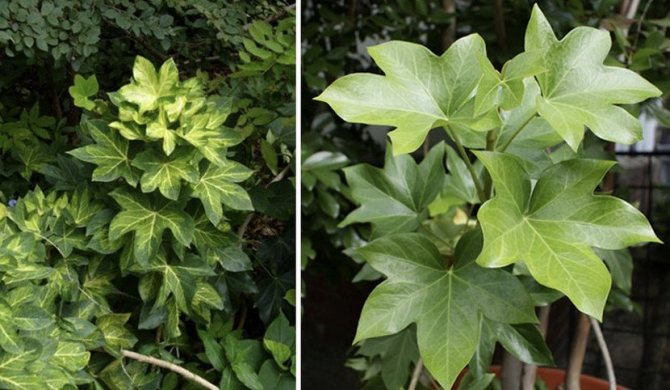

But if you plant a vine outside the house, then it will turn from an offender into a defender: it will become a kind of armor through which negative emotions and aggressive energy cannot get into the house.
However, there is an alternative opinion that fatskhedera is also useful inside the house - it cleans the biofield of the dwelling, stimulates optimism and good thoughts among residents, develops calmness and confidence.
Did you know? Fatshedera is especially suitable for those born under the signs of Libra and Virgo.
As you can see, it is quite easy to become the owner of an exotic plant with the unusual name "Fatshedera". The belief that "French women" are capricious does not come true in the case of this flower, since it does not require special care or conditions. But if you are a superstitious person, you should think carefully before purchasing a fatsheder so as not to harm yourself or the flower.
Reproduction of fatshedera cuttings
Cutting is an easy and affordable way to breed fatshedera. For this purpose, before the beginning of the growing season, a 15 cm long shoot is cut off from the vine, which has several "dormant" buds and rooted in a wet peat-sand mixture, or in water.
In the first case, the cuttings are covered with a film, they are provided with greenhouse parameters. In the second, a temperature of at least 25-27 ºС is also created, ventilation is organized. When young leaves appear, the sprouts are dived into a separate container.
Moreover, amateur flower growers propagate fatshedera by layering... In this variant, the appearance of the first roots occurs no earlier than two months later.
Diseases and pests
The main problems that a florist may face when breeding fatshedera:
- lower leaves of fatshedera fall as a result of the natural process of foliage withering away;
- Fatsheder leaves turn yellow with constant abundant soil moisture;
- Fatshedera has elongated shoots , which indicates a lack of sunlight;
- small leaves fatshedera are also a sign of a lack of lighting;
- the edges of the leaves fatshedera dry with rare watering and dry air;
- dry spots on the leaves appear if the plant is placed under the scorching sun and burns;
- leaves lose brightness due to the location of the flower in a too dark place, or with an acute shortage of certain trace elements.
Among pests, liana is most often affected by: mealybug, whitefly, spider mite.
Possible difficulties
This hybrid is disease resistant. A number of problems can be associated with improper care:
- leaves turn pale and lose their variegation - lack of sunlight;
- the leaves turn yellow and curl - the gulf of soil;
- foliage edges dry out - low humidity;
- rounded brownish spots form on the foliage - a burn.
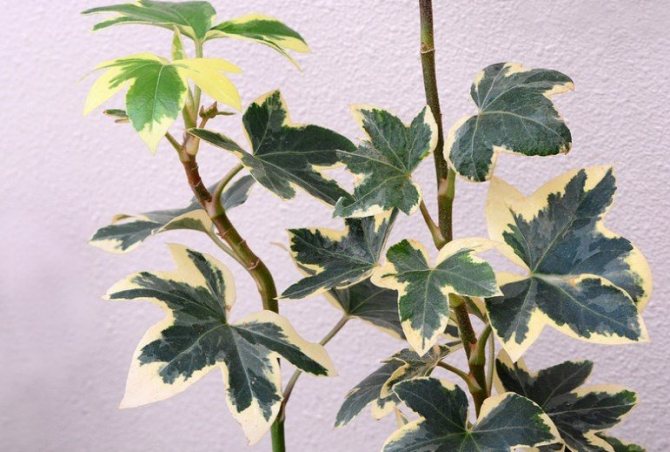

On juicy shoots, spider mites, aphids and mealybugs are periodically found. First of all, you should rinse the vegetation under a plentiful warm shower and wipe the leaves with soapy water. If the parasites have not disappeared within 2-3 days, they are treated with an insecticide.
Possible problems and solutions
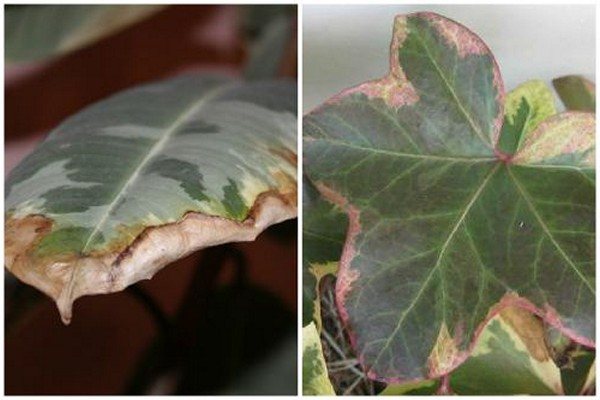

Fatshedera: photos
During the cultivation of a flower, Fatsheders often experience various troubles, which will be discussed below. If you notice that the leaves from above begin to turn yellow, and also become dry, or strange spots have appeared on them, this indicates an incorrect watering regime. Thus, there is not enough water. Provided that the temperature of the air where the vine is grown is more than 25 degrees, the leaves can become lethargic and ugly. The solution to the problem will be to increase the watering of the bush, and the humidity in the room should also be increased. If you see brown spots on the leaves of a sufficiently large size, and the leaf surface has begun to unwind, it means that the sun's rays are too brightly exposed to it, which caused these burns. In this case, it is imperative to rearrange the plant to another place.
If the leaves have ceased to be glossy, this indicates that Fatskhedera is not sufficiently lit. The solution to the problem would be, again, moving the pot to another place that is more brightly lit by the sun.
If you notice that the Fatshedera houseplant has withered, and gray pubescence has formed on it, this indicates that the air in the room is excessively humid, as well as the temperature is unsuitable.To solve the problem, you should rearrange the plant again or organize such conditions so that the air temperature becomes higher, and the humidity, on the contrary, decreases slightly. All affected and unsightly parts of the plant must be cut off, and the soil in the pot must be loosened. In order to avoid the occurrence of rot, it is necessary to treat the bush with a fungicide.
Also, the leaves can fall during the physiological aging processes of the plant, so do not panic.
Pests
Lack of moisture in the air can cause pests. The most common pests are spider mites, mealybugs, scale insects and whiteflies.
When a spider mite appears, the leaves are covered with a whitish cobweb. With a slight lesion, you can wipe the leaves with soapy water, alcohol. The scale insect is a brown insect. She settles on the leaves, sucking the juices from the plant. Whitefly lays eggs, from which white larvae emerge, feeding on plant sap. They settle on the underside of the leaf, on cuttings. The mealybug gets its name from the fact that a white bloom appears on the leaves, similar to flour.
Both folk remedies and chemical preparations are suitable for pest control. With a small number of pests, it is better to use folk methods of struggle. The leaves of the plant are wiped with soapy water, cotton swab dipped in alcohol. Some growers recommend rinsing the plant with pet flea shampoo, as it contains the insecticide pyrethrin. Among other tips, you can recommend the treatment with the infusion of tobacco dust. To fight the whitefly, it is sometimes enough to give the fatskhedere a warm shower.
In case of significant damage to save the plant, it is necessary to use insecticides such as Aktellik, Aktara. They can be replaced with others available in the store. The main thing is to follow the instructions and take the necessary safety measures when processing a flower. After seven to ten days, the treatment must be repeated.
Lighting and air temperature
Unlike fatsia, fatshedera prefers bright lighting, but indoor specimens are best protected from direct sunlight. Only under such conditions will flowering and fruiting occur. The plant adapts to partial shade, but in this case, backlighting in winter is desirable. Variegated forms are especially sensitive to the level of lighting (in the photo below), with its lack, the effective contrast on the leaves is lost, the beauty of the fatshedera fades.
Caring for a plant at home involves organizing the correct temperature regime throughout the year. The hybrid needs coolness. In summer, the air temperature in the room should be moderate, preferably not higher than + 18-23 ° С, and in winter it should be kept in the range of + 5-18 ° С. The plant is resistant to cold, therefore in warm regions it is grown in gardens.


Shine
Like almost any houseplant, the vine requires a lot of sunlight. The optimal place for the growth and development of a plant will be an open sunny room, where a large amount of sunlight will constantly be present. Only very slight shading is permissible so that the plant does not lose its decorative appearance.
In spring and summer, it is permissible to grow this plant on the site. You can take it out directly in the pot where it grew indoors, or you can take it out to the balcony or terrace. If you have a small enclosed yard, then the plant will feel very good there too. However, when choosing a place, it must be borne in mind that there should not be scorching sunlight here, as this can lead to burns of the sheet plates.
Watering and humidity
For the plant, it is necessary to provide abundant, but not excessive watering during the period of active growth.Excess water from the pan must be drained immediately, the plant reacts painfully to waterlogging of the soil, as a result of which the leaves may turn yellow.
In winter, watering is provided moderately, but at the same time it is necessary to ensure that the earthen lump does not completely dry out. If you dry out the earthen lump at least once, the leaves may fall, the shape of the crown may change, all this is quite difficult to return to its previous position.
When keeping the plant in cool conditions, no special care is required. But if the plant is kept at a temperature of 18 degrees and above, the plant needs additional moisture.
It can be placed on a pallet with damp expanded clay or pebbles above the water level, as well as to ensure frequent spraying of the leaf cover. Wipe the dust off the leaves about once a week, preferably using a soft, damp cloth.
Description of the plant
The Fatskhedera flower is a herbaceous, evergreen perennial. Its root system is fibrous with gradually lignified dark brown roots. A long, creeping vine sits above the soil surface. It gives few lateral shoots, but is capable of growing up to 5 m. The annual growth is about 30 cm. Over the years, smooth dark green stems are covered with brown, rough bark.
Large petiole leaves, depending on the variety, are divided into 3-5 lobes. They have a glossy dark green surface. In addition to varieties with monochromatic foliage, variegated species are found. The sides of the leaf plate are smooth or slightly wavy, and the edge of each lobe is pointed.
In August-September, multiple umbellate inflorescences of nondescript flowers are formed in the leaf axils. The buds are yellowish green or cream colored. Fatskhedera fruit is a juicy, rounded purple or dark blue berry. It contains several small seeds.
Transfer
Ivy is transplanted in the spring after 1-3 years. The pot is selected deep and stable. A layer of drainage material (expanded clay, pebbles, broken brick, clay shards) is poured onto the bottom. Neutral or slightly acidic soils are preferred. The composition of the land of Fatskhedera is undemanding. You can use garden soil with the addition of peat and river sand. When transplanting, the transshipment method is used.
If the Fatskhedera grows at home in a large floor tub and it is difficult to transplant it, it is recommended to remove the top layer of soil every 1-2 years and replace it with a fresh one. Also, it will be useful to periodically loosen it regardless of the season. This will allow the roots to get the oxygen they need.
Fatskhedera omens and superstitions
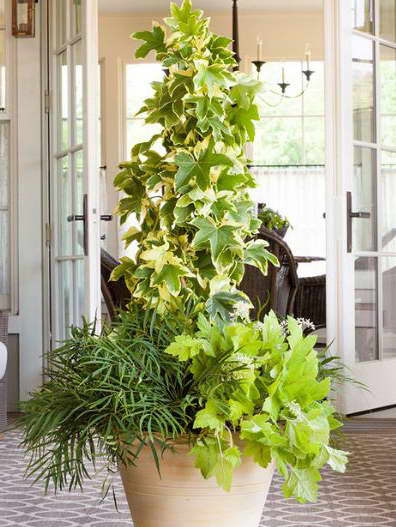

Fatshedera plant energy
According to popular belief, ivy plants suppress male energy, displacing male representatives from the house. Men feel uncomfortable and try to spend less time in places where fatshedera grows.
They are also considered energy vampires that take away vitality, they deprive them of optimism, negatively affect mental balance. But, if you place the plant outside the house, on the contrary, it will serve as a talisman against the effects of aggressive energy and negativity.
Features of fatsheders
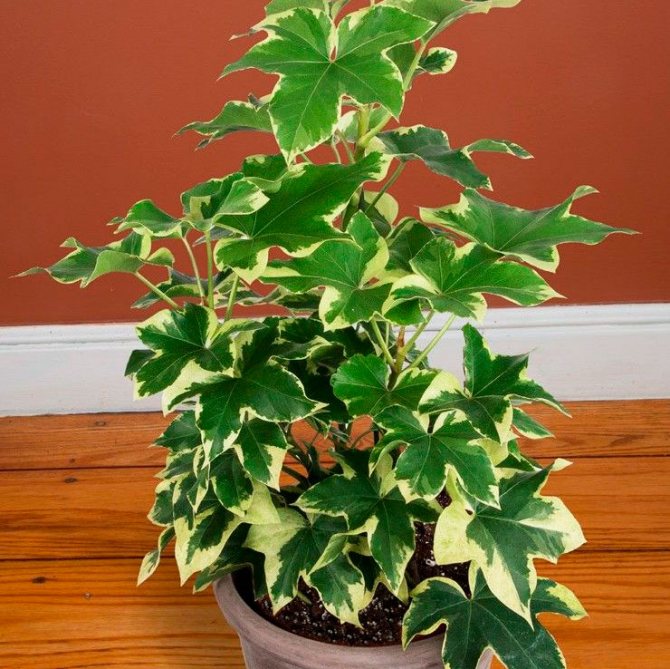

Fatshedera is inherently a rare exotic plant. A very short time after this vine was created, it became very popular among both florists and florists. It is often used to decorate flower arrangements, and is also quite often grown on terraces, balconies and conservatories. And such a flower looks great in a spacious hall or foyer.
Fatshedera is distinguished from other plants by large dark green glossy leaf plates that look like ivy and fatsia foliage. Throughout the entire period of foliage growth, its color does not change. The length of the sheet plate is about 30 centimeters, and its width is about 20 centimeters.Their shape can be finger-lobed or trifoliate. Very often, in the subspecies of fatshedera, an irregular border of a white or cream shade passes along the edge of the leaf plate, thanks to which the plant becomes even more spectacular and graceful.
In length, the bush can reach about 5 meters. At first, it looks like a tree with a semi-lignified weakly branched stem. If there is a desire, then the vine can be constantly grown in the form of a tree, but for this you need to install a support (bamboo or wooden stick). If you pinch the shoots of the tree, then you can form a shrub that will delight you with its gorgeous green foliage for a long time. If there is no support, then the shoot will begin to creep, and over time it will look more like a vine. As it grows, the stem becomes lignified, and a dark brown bark appears on its surface. During the year, such a plant grows in length by 0.3–0.4 m.
In an adult fatskhedera, in the last summer or in the first autumn weeks, the formation of spherical umbrellas-flowers is observed, which can be painted in a cream or yellowish-green hue. Such flowers are part of paniculate inflorescences. At the end of flowering, dark blue berries are formed on the bush. This plant is very hardy and can be grown outdoors, but only in regions where winters are mild and not too cold are suitable for this. When choosing a place for a vine, keep in mind that it needs a lot of bright light.
Fatskhedera plant species
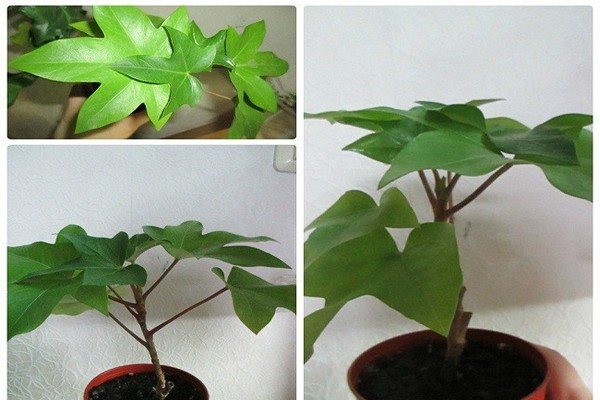

Fatshedera: photos
The following types of plants are very popular:
Fatshedera Variegata. The leaf plates here have a dark green hue, as well as a creamy border over the entire surface. Fatskhedera Variegata grows very quickly, but often falls ill with various ailments.
Fatskhedera Pia (pia). Fatskhedera Pia has very bright large green leaves that are not very large. In addition, the leaves of Fatshedera Pia are characterized by a wavy edge and short petioles.
Silver prince... This culture is named due to a certain silvery shade on the edge of each leaf plate.
Golden variety. The culture is characterized by golden spots that are located on each leaf.
Plant transplant and fertilization
Young plants need an annual transplant in the spring, and already with age they are transplanted once every 2-3 years. The soil is made up of 2 parts of sod land, 1 part of sand and 1 part of humus. Also, the Fatskhedera plant needs good drainage, it should occupy 1/3 of the pot.
Top dressing should be done from April to September, during this period the phase of active growth occurs, alternating complex organic and mineral fertilizers, approximately once every 10 days. In winter, the plant does not need fertilization.
Photo of indoor flower
Examples of what a beautiful Fatshedera plant looks like in an open space.
How does it multiply
It is better to plant fatskhedera in the warm season: in the southern regions in mid-spring, in the northern ones in early summer.
Cuttings
The apical grafting procedure is carried out using a sharp knife. A shoot with a height of 15-17 cm is cut and placed in a moist substrate (sand and peat in equal parts).
The greenhouse effect is created when covered with a film.
Cuttings take root in 7-10 days. After the appearance of the first buds, the film is removed, watering is increased.
Seeds
Seed propagation is more often used for rare variegated varieties (Variegata, Silver Prince). When buying seeds, it is important to check the expiration date.
It is better to sow in spring. The seeds are not buried, but sprinkled with a centimeter layer of earth. Before germination, the mini-greenhouse is placed in a dark place with a temperature of + 25-27 ° C.The grown seedlings are planted in small pots.
Air layering
In early spring, a shallow circular incision is made on the trunk. Then they wrap it in wet moss, cover it with cling film on top. After the roots appear, the twig is carefully cut off. Then they are transplanted into a plastic cup, covered with glass or polyethylene and placed in a shaded place for rooting.
Reproduction methods
Reproduction of fatsheders is carried out in a vegetative way. Apical petioles and mature leaves can be used. The cuttings are rooted in water at a temperature of +25 ° C. You can immediately plant the shoots in moist peaty-sandy soil and cover with a bag. The rooting process is very slow, it will last at least a month. Saplings that are rooted in water are planted in the ground with the appearance of short roots. For a week after transplanting, they are also kept under a film in a humid, warm environment.
Rooted cuttings are carefully transplanted into pots, 2-3 seedlings together. This method of planting will allow you to get more lush growth.
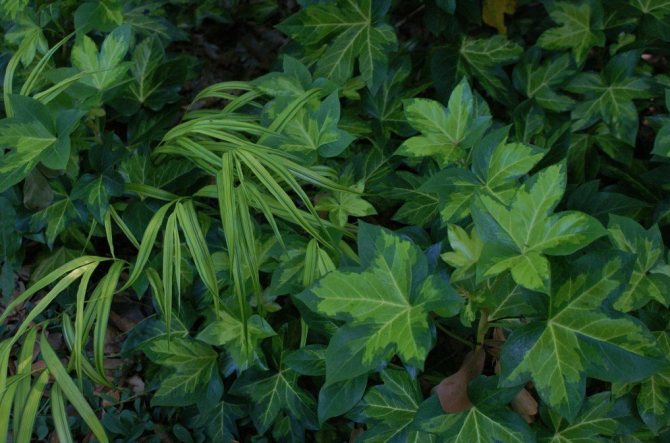

Pruning Fatshedera
To slow down growth and give decorative effect, it is recommended to pinch young shoots. Pinching of shoots can be carried out throughout the growing season. Over time, the lower leaves crumble, the stem stiffens. Therefore, for rejuvenation, the old branches are cut in half in the spring.
The flexibility of young shoots can be used to guide their growth along decorative supports. Modern decorative supports are not only vertical supports, but also various arches. This allows you to create an original decoration of an office or apartment, a winter garden.
Plant characteristic
The Fatshedera flower is exotic and less common among domestic crops. Some time after the release of this culture, florists and other experienced florists fell in love with it. This culture is grown for decorative purposes for landscaping and beautifying various attics, complementing it with flower combinations, flower beds, and also actively growing in winter gardens. Culture can bring a fresh touch to any spacious lobby or foyer of public institutions.
The leaves of this plant have a shiny surface and are distinguished by a dark green tint. In shape, the leaf plates have the same leaves as ivy. The color of the leaves does not change during the growth and development of the plant. The length of the leaf is, as a rule, 30 cm, while in the cross-section the leaf is not more than 20 cm. Thus, the shape of the leaves is finger-like or may be trifoliate. There are varieties of fatsheders, which also have a different color passing along the border of the sheet plate. It is usually lighter or creamier in color. Such cultures are even more exotic.
In general, the plant reaches 5 m in height. At the beginning of its development, it outwardly looks like a tree, which has a lignified or semi-lignified stem. Here everything will depend on the wishes of the grower and on how the bush will be formed. You can leave this plant as a tree, having previously installed a supporting structure next to it. If you regularly form a bush, then it will grow in the form of a shrub, it will become more lush, branched and look more impressive.
If you do not put a support, so the vine will droop and droop. In an adult tree, the stem is already lignified and even a thin layer of dark bark is formed. Every year the plants grow by about 30-40 cm.
The Fatskhedera liana flower has a flowering period that occurs in late summer and early autumn. The flowers are formed in the form of umbrellas or in the form of a ball. The shade of flowers is usually light green or cream. After the flowering period ends, the fruits ripen in the form of berries, which have a dark blue color. The plant is very hardy and adapts well to outdoor conditions.However, this is possible only in those regions that are characterized by a mild warm climate.
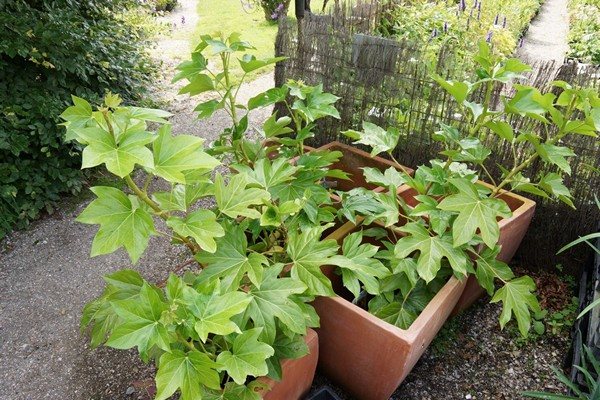

Fatshedera flower: photo

